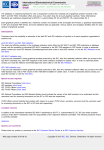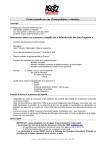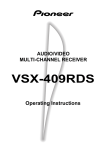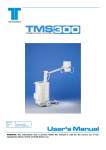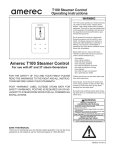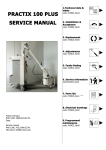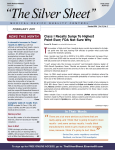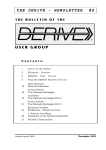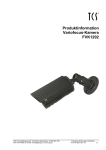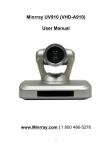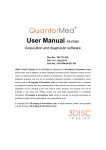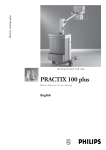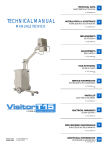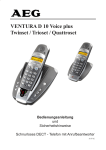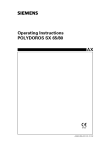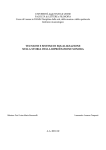Download INSTRUCTIONS FOR USE Optimus 50/65/80
Transcript
radiography mA-s AEC Reset 70 kV – + Oesophagus 25 mAs – + 50 ms – 110 kV 3.5 mA 2:45 Ventriculus Rectum Duodenum Thorax Colon + Menu INSTRUCTIONS FOR USE Optimus 50/65/80 X-ray generator version 3.6 4512 109 24973 AB/742 – 11.2005 English Instructions for Use All rights reserved. Philips Medical Systems DMC GmbH reserves the right to make changes in specifications or to discontinue any product, at any time without notice or obligation, and will not be liable for any consequences resulting from the use of this publication. Internet adress: http:// www.philips.com/ms Copyright © by 2005 Philips Medical Systems DMC GmbH Roentgenstrasse 24 D-22335 Hamburg, Germany This manual is a translation from the German. When receiving data media the user acquires a non-exclusive, nontransferable right to use the software stored on them in connection with the hardware components delivered with it by Philips. Philips Medical Systems Changes to software, the use of which on hardware components other than those delivered by Philips in this connection (multiple use) or the making of copies, even for purposes of data backup, must be approved by Philips in writing beforehand. 1 Worth to know 1.1 1.2 1.3 1.4 1.5 1.6 2 Safety 2.1 2.2 2.3 2.4 2.5 3 About this manual ........................................................................... 7 Electrical safety ................................................................................ 7 Electromagnetic compatibility (EMC) ............................................. 7 Radiation protection ........................................................................ 8 Disposal........................................................................................... 8 Function and description 3.1 3.2 4 The Optimus generators .................................................................. 5 Normal use ...................................................................................... 5 For safe operation ............................................................................ 5 Conformity...................................................................................... 6 Training .......................................................................................... 6 Other Instructions for Use ............................................................... 6 The function.................................................................................... 9 The control desk............................................................................ 14 Operation 4.1 4.2 4.3 4.4 4.5 4.6 4.7 4.8 4.9 Operation of all configurations ...................................................... 22 Operation of the basic configuration.............................................. 23 Operation with AEC, without APR ............................................... 25 Operation with APR, without AEC ............................................... 27 The APR records ........................................................................... 27 Operation with AEC and APR ...................................................... 32 Tomography.................................................................................. 36 Fluoroscopy ................................................................................... 40 Dose display .................................................................................. 43 5 Maintenance 5.1 5.2 5.3 5.4 5.5 5.6 5.7 6 Technical data 6.1 6.2 6.3 6.4 6.5 6.6 6.7 7 Tests by the user ............................................................................ 44 Checking performance of dose rate control / AEC function according IEC 60601-2-7 ...................................... 45 Safety checks according to the Medical Device Directive ............... 45 Maintenance.................................................................................. 46 Recording results ........................................................................... 46 Cleaning ........................................................................................ 46 Disinfection................................................................................... 47 Electrical data ................................................................................ 48 Setting ranges ................................................................................ 49 Ambient conditions for operation .................................................. 50 Accuracy of the operating data, tolerances ..................................... 50 Compatibility ................................................................................ 52 Methods of measurement .............................................................. 52 Type number plate ........................................................................ 52 Appendix 7.1 7.2 7.3 7.4 7.5 7.6 Error messages ............................................................................... 53 The hierarchy of levels on the display ............................................ 54 Screen-film combinations .............................................................. 55 Key symbols and their meanings .................................................... 55 Exposure table ............................................................................... 56 Abbreviations and their meanings .................................................. 60 Index 1 1.1 Worth to know The Optimus generators The generators Optimus 50/65/80 are converter generators and controlled by microprocessors. The basic version contains an control desk and a standard housing with automatic control and high voltage generator. The control desk is available without automatic programmed radiography (APR) and automatic exposure control (AEC) as well as with APR and/or AEC. 1.2 Normal use With the Optimus generators you can perform fluoroscopy and make diagnostic X-ray exposures within the scope of their technical data and descriptions. 1.3 For safe operation • You must never use the X-ray equipment if it has any electrical, mechani- • • 2 1 N o v. 2 0 0 5 • Philips Medical Systems • • • Optimus 50/65/80 Version 3.6 cal or radiation defects. This particularly applies to malfunctioning indication, warning and alarm devices. If the user wishes to connect the X-ray equipment to other equipment, components or assemblies and if it is not apparent from the technical data whether it can be safely combined with such equipment, components or assemblies, the user must ensure that the safety of the patient, operating staff and the environment is not affected by the planned combination by consulting the manufacturers involved or by making enquiries from an expert. Philips is responsible for the safety features of its products only if maintenance, repairs and modifications have been performed by Philips or by persons explicitly authorised to do so by Philips. As with any technical appliance, this equipment requires not only correct operation but also regular, competent maintenance and care, which are described in the section ”Maintenance“. If you operate the X-ray equipment incorrectly or if the user fails to have maintenance carried out properly, Philips cannot be held liable for any malfunctions, damage or injuries. Safety circuits must be neither removed nor modified. You may remove or open parts of the housing only if you are instructed to do so in this manual. Worth to know 5 1.4 Conformity 1.4 0123 Conformity This Medical Device meets the provisions of the Medical Device Directive MDD 93/42 EEC (93). If you have further questions regarding the applicable national or international standards, please address them to: Philips Medical Systems DMC GmbH Quality Assurance Department Roentgenstrasse 24 D-22335 Hamburg Fax: (+49) 40/5078-2147 1.5 Training The X-ray equipment may only be operated by persons who have the necessary expertise in radiation protection or knowledge of radiation protection and who have been instructed in how to operate the X-ray equipment. 1.6 Other Instructions for Use Philips Medical Systems This X-ray generator is part of a system. The other system components are described in seperate manuals. 6 Worth to know Optimus 50/65/80 Version 3.6 About this manual 2 2.1 2.1 Safety About this manual This manual is intended to enable you to work safely with the X-ray equipment described. You may only use this equipment in compliance with the safety instructions in this manual and not for purposes other than those for which it is intended. It is always the user who is responsible for complying with the regulations which apply to the setting up and operation of X-ray equipment. 2.2 Electrical safety This X-ray equipment meets the safety class I and type B according to IEC 60601-1. Only trained maintenance staff may remove the covers from the high-voltage cable of the X-ray tube assembly and the high-voltage generator. This X-ray equipment may only be operated in medical rooms which meet IEC requirements. • You must never operate this X-ray equipment in areas where there is a risk of explosion. • Detergents and disinfectants, including those used on patients, may create explosive mixtures of gases. Please observe the relevant regulations. 2.3 Electromagnetic compatibility (EMC) 2 1 N o v. 2 0 0 5 In accordance with its intended use, this electronic apparatus complies with the law governing EMC, which defines the permitted emission levels from electronic equipment and its required immunity against electromagnetic fields. Philips Medical Systems Nevertheless, it is not possible to exclude with absolute certainty the possibility that radio signals from high-frequency transmitters, e.g. mobile phones or similar mobile radio equipment, which themselves conform to the EMC regulations, may influence the proper functioning of electromedical apparatus if such equipment is operated in close proximity and with relatively high transmitting power. Therefore, operation of such radio equipment in the immediate vicinity of electronically controlled medical apparatus should be avoided to eliminate any risk of interference. Explanation: Electronic apparatus that satisfies the EMC requirements is designed so that under normal conditions there is no risk of malfunction caused by electromagnetic interference. However, in the case of radio signals from high-freOptimus 50/65/80 Version 3.6 Safety 7 2.4 Radiation protection quency transmitters with a relatively high transmitting power, the risk of electromagnetic incompatibility when operated in close proximity to electronic apparatus cannot be totally ruled out. In unusual circumstances unintended functions of the apparatus could be initiated, possibly giving rise to undesirable risks for the patient or user. For this reason, all kinds of transmission with mobile radio equipment should be avoided. This also applies when the apparatus is in ”standby“ mode. Mobile telephones must be switched off in designated problem zones. 2.4 Radiation protection • Ensure that before performing any radiography all the necessary radiation precautions have been taken. Information about radiation protection you can find in the different Instructions for Use for the X-ray equipment used with this generator. • Safety circuits which may prevent X-radiation from being switched on under certain conditions may be neither removed nor modified. 2.5 Disposal Take-back, proper disposal and recovery of the Medical Device take place in accordance with the European WEEE Directive (Waste Electrical and Electronic Equipment) and/or respective requirements of national legislation. Philips manufactures state-of-the-art X-ray equipment in terms of safety and environmental protection. Assuming no parts of the system housing are opened and assuming the system is used properly there are no risks to persons or the environment. To comply with regulations it is necessary to use materials which may be harmful to the environment and therefore have to be disposed of in a proper manner. Philips • supports you in disposing of the X-ray equipment described in a proper manner • returns reusable parts to the production cycle via certified disposal companies and • thus helps to reduce environmental pollution. Consequently, do contact your Philips Service Organisation in full confidence. 8 Safety Optimus 50/65/80 Version 3.6 Philips Medical Systems For this reason you must not dispose of the X-ray equipment together with industrial or domestic waste. The function 3 3.1 3.1 Function and description The function This generator produces the voltages and currents required for operating an X-ray tube and makes the supply voltages available for parts of the X-ray system as a whole. 3.1.1 What the generator is capable of In the following table you can see what configurations offer what exposure techniques: Radiography and Configuration fluoroscopy techniques Basic version with APR with AEC with APR without APR, without without and AEC AEC AEC APR kV technique – – + + kV-mA technique – – – + TDC – – – + kV-mAs technique + + + + kV-mAs-s technique + + + + kV-mA-s technique – + – + special exposures for – +3 – +3 +1 +2 +1 +2 therapy simulation Fluoroscopy technique Philips Medical Systems 2 1 N o v. 2 0 0 5 + possible – impossible 1 only one kV-mA characteristic possible 2 Customer Service can assign different kV-mA characteristics to the various APRs 3 Fluoroscopy must be available 3.1.2 Possible configurations: • • • • Basic version Also with AEC (Automatic Exposure Control, optional) Also with APR (Anatomically Programmed Radiography, optional) Also with AEC and APR (optional). This Operator‘s Manual describes all configurations. Optimus 50/65/80 Version 3.6 Function and description 9 3.1 The function 3.1.3 Functions of the maximum configuration: • Exposure techniques - APR with automatic exposure control (AEC) - APR without automatic exposure control • Techniques with automatic exposure control (AEC) - kV technique - with maximum tube power according to the focal spot selected or - with fixed current within the adjustable values - tomography (TDC, Tomography Density Control)) • Techniques without automatic exposure control - kV-mAs technique - kV-mA-s technique - kV-mAs-s technique 3.1.4 Other functions • Change exposure data of an APR program Philips Medical Systems • • • • - for the next exposures (without saving) - with saving afterwards Save up to 1,000 APR programs Adapting the exposure data to the thickness of the patient’s body Area dose product (optional, depends on system) Variofocus (optional) With the Variofocus function you can select a focal spot the properties of which are between the large and small focal spots. The ratio of the two focal spots is stated as a percentage of the small focal spot. “20% SF“ means 20% weighted power of the small focal spot and 80% weighted power of the large focal spot. The Variofocus is set for each APR program during installation. 10 Function and description Optimus 50/65/80 Version 3.6 The function 3.1.5 3.1 What’s new? This Operator’s Manual describes the generator with all possible functions at the time of going to press. Relevant for the functions available in the generator is the acquired or upgraded configuration. This Operator’s Manual also describes all the earlier generator versions. The following table informs you about all possible functions. Function from version Option AEC (Automatic Exposure Control) 1 + Automatic tomo time input 1 +2 APR (Anatomically Programmed Radiography) 1 + APR extension 2 2,5 Display of area dose product 2 +1 Variofocus 2 +2 Display of the thermal state of tube assembly 2 +4 TDC (Tomography Density Control) 2 +2,6 kV technique with fixed current 2 +2,6 PDO (Patient Data Organizer) 2 +3 Fluoroscopy 3 Special exposure for therapy simulation 3 +2,7 Photomultiplier adapter 3 +6 1 compatibility depends on the system only with APR 3 see Operator’s Manual for PDO 4 depending on the system and tube assembly 5 always included (without control module) 6 only with AEC 7 only with fluoroscopy Philips Medical Systems 2 1 N o v. 2 0 0 5 2 Optimus 50/65/80 Version 3.6 Function and description 11 3.1 The function 3.1.6 What you have to know before switching on • Please observe the instructions on safety and maintenance. • If a button • • • • • • - is lit: the function or the auxiliary is activated. - is not lit: the function or the auxiliary is deactivated. If you reach a limit, the display goes out briefly and reappears. If you change a value and this causes a change in the mAs value, for example, the new value will be indicated. If you wish to change a non-variable value, the value is retained, whilst the display goes out briefly and reappears. After the end of an exposure there is an audible signal and the actual exposure data appear for 25 s as a post-exposure display or until the next operator action only with AEC. With you can call up the post-exposure display again provided you have not released any new exposure. You can make up to three exposures a minute in any sequence. When doing so it is absolutely essential that you observe the tube assembly status display and the information contained in the Instructions for Use delivered with the tube assembly. If you attempt to make a fifth exposure within one minute, it will not be released. The generator prevents any further exposure for one minute. Exceptions: • There is no limitation to four exposures per minute - if you release fluoroscopy within one minute and before the fourth exposure at the latest or - in the serial mode. For pediatric exposures please read the note in chapt. 3.2.1. 3.1.7 Monitoring system for conditions for shutting down radiography The generator has a monitoring system which in the event of an error protects against uncontrolled radiation, within the scope of foreseeable possibilities. With radiography using automatic exposure control this monitoring system interrupts the radiation if any of the following conditions is met: • Stage 1: If the mAs value has reached 9.5 times the mAs value of the type of exposure selected • Stage 2: If after 10% of the maximum permissible exposure time at least set lower by the Customer Service. If you change an APR program temporarily, stages 1 and 2 switch off. This will be displayed by an asterix „*” (see section 4.5.4). Stage 2 remains activated for these 10% of the maximum exposure time, even stage 3 remains activated. If you wish to accept the changed program as a fixed program, you must enter the mAs values to be expected via the mAs technique in order to adapt stages 1 and 2 to the new programming (for reference you will find an exposure table in the Appendix). Then stages 1 and 2 are reactivated. 12 Function and description Optimus 50/65/80 Version 3.6 Philips Medical Systems 4% of the expected switch-off dose has not been reached • Stage 3: If 600 mAs or 4 s has been reached. The value of 600 mAs can be 3.1 Function and description 13 Philips Medical Systems 2 1 N o v. 2 0 0 5 The function Optimus 50/65/80 Version 3.6 3.2 The control desk The control desk 3.2 Keys and displays – short and briefly 3.2.1 1 3 2 4 6 5 7 8 mA-s Reset 13 AEC 14 21 70 kV 25 mAs 50 ms 11 12 9 10 15 22 16 23 17 24 – + – Oesophagus + + – 110 kV 3.5 mA 2:45 Ventriculus Rectum* 28 18 25 Duodenum 19 26 Colon 20 27 29 Thorax Menu 30 31 The displays illustrated are examples. The exposure switch is a two-step switch. Step 1: Preparation – The green Ready indicator goes out. When it lights up again: You can press the button straight through to the second position. After the preparation time the exposure is released. Keep the button pressed until the end of exposure or else the exposure will be aborted. Never press the button more than three times in one minute. In this way you will extend the life of the X-ray tube. Specially for paediatric exposures and casualty departments, for example, Customer Service can program the preparation time to 30 s for each tube selected. Preparation remains on even after letting go of the exposure button from the ”Preparation“ stage, provided no exposure has been released. After exposure, preparation is switched off. 14 Function and description Optimus 50/65/80 Version 3.6 Philips Medical Systems Step 2: Release exposure. The control desk No Description 1 Switch off generator 2 Switch on generator 3 Select exposure technique 4 Ready for exposure 5 radiation is switched on 6 Display of the tube state 7 Incorrect exposure indicator 8 Reset functions 9 Switch on/off automatic exposure control 10 Selection and display of exposure voltage 11 Selection and display of exposure current 12 Selection and display of exposure time 13 Call up different levels 14 Spot film device 15 DSI 16 Angiography with Puck 17 Free cassette 18 Small focal sopt 19 Variofocus (optional) 20 Large focal sopt 21 Spot film device, tomography 22 DSI, tomography 23 Wall stand 24 Tomography attachment 3.2 2 1 N o v. 2 0 0 5 25 26 Select measuring chambers of automatic exposure control Philips Medical Systems 27 Optimus 50/65/80 Version 3.6 28 Display 29 Slim patient 30 Stout patient 31 Scroll through the display pages Function and description 15 3.2 The control desk 3.2.2 Keys and displays – detailed mA-s AEC Reset 70 kV – + Oesophagus 25 mAs – + 50 ms – + 110 kV 3.5 mA 2:45 Ventriculus Rectum* Duodenum Thorax Menu Philips Medical Systems Colon 16 Function and description Optimus 50/65/80 Version 3.6 The control desk 3.2 The upper display Display and selection of the generator data. Green Ready lamp: ready to make an exposure Radiation is switched on Display of tube assembly state (depending on system and X-ray tube assembly, please also observe the instructions in the instructions for use for the X-ray tube assembly). Colour(s) Description green Full power available yellow + gren The tube assembly is warm, full power available yellow Up to 80 % of the full power is available yellow + red Up to 64 % of the full power is available red The thermo syfety switch in the tube assembly is activated: – radiographyy not possible – fluoroscopy current is limited to 3 mA Incorrect exposure indicator; if it flashes • you have let go of the exposure switch prematurely; press Reset or • the limit of exposure time or mAs has been reached; press Reset or • the exposure has been aborted owing to incorrect exposure (incorrect exposure early warning system), press Reset . Display in the exposure data panel with AEC: kV, kV-mA and TDC techniques (Display on the first level, example) 70 kV – + 0 – G200ST + – + 2 1 N o v. 2 0 0 5 Display and selection of • exposure voltage • density correction at SFC only (at radiography with image intensifier only display) • screen-film combination (SFC, not for radiography with image intensifier) Philips Medical Systems Post-exposure display (Display on the second level, example) 70 kV – + 25 mAs – + 50 ms – + The values of post-exposure display are marked by a triangle. Optimus 50/65/80 Version 3.6 Function and description 17 3.2 The control desk Display in the exposure data panel for the kV-mAs or kV-mAs-s technique: (Display on the first level, example) 70 kV – 25 mAs + – + 50 ms – + Display and selection of • exposure voltage • mAs product • exposure time (selection only possible for kV-mAs-s technique) Display in the exposure data panel for kV-mA-s technique (Display on the first level, example) 70 kV – 500 mA + – + 50 ms – + Display and selection of • exposure voltage • exposure current • exposure time Change exposure data • in steps: press – or + briefly • continuously: press – or + longer As an alternative to exposure data, error messages or instructions appear for the operator. For more information refer to the Appendix. Philips Medical Systems For information about the displays on levels 2, 3 and 4 refer to the Appendix (see chapter 7.2). 18 Function and description Optimus 50/65/80 Version 3.6 The control desk 3.2 The lower display Oesophagus 110 kV 3.5 mA 2:45 (line 2, column 1) (line 2, column 2) (line 3, column 1) (line 3, column 2) (line 4, column 1) (line 4, column 2) Display and selection of the APR programs, the current selection is highlighted. If there is an APR menu, ”Menu“ appears on line 4, column 2. You can call it up with the button . With you can scroll through the pages if the LED is lit and at least two pages have been programmed. After the last page, page 1 appears again. If, after scrolling, you press the exposure switch on ”Preparation“ the following appear: • the APR program last selected • the appropriate exposure data. Philips Medical Systems 2 1 N o v. 2 0 0 5 If you have modified the data of a program, an asterisk appears after the name of the program. The modified data remain intact (even if you change the auxiliary for example) until you select the same program again or a different one. Optimus 50/65/80 Version 3.6 Function and description 19 3.2 The control desk mA-s AEC Reset 70 kV 25 mAs + – + – Oesophagus 50 ms – + 110 kV 3.5 mA 2:45 Ventriculus Rectum* Duodenum Thorax Colon Menu Skull pa Skull lat Nasal access. sinuses Lungs lat Skull Schüller Skull Stenvers Shoulder Pelvis survey Dorsal spine ap Dorsal spine lat Rips Abdomen Lumbar spine ap Lumbar spine lat The 18 buttons on an optional keypad module are assigned as follows: • 14 buttons for APR programs, each button can be assigned any auxiliary • 2 buttons for selecting the auxiliairies • 2 buttons for adjusting exposure data to the thickness of the patient’s body 20 Function and description Optimus 50/65/80 Version 3.6 Philips Medical Systems Optional keypad module (example) (APR assignment, maximum configuration, depending on the system) The control desk 3.2 The keys and their functions . Symbol Description Switch off generator Switch on generator mA-s Toggle between kV-mA-s technique (LED is lit) and kV-mAs-s or kV-mAs technique (alternatively programmable) AEC Switch on/off automatic exposure control Reset – Switch off incorrect exposure indicator – Save modified APR data together with an APR button – Clear error message – New patient (PDO, option) – Switch off audible signal after 5 min of fluoroscopy Call up different levels Select focal spot: Small focal spot Veriofocus (option) Large focal spot, standard at monofocal tubes Select measuring field(s) of the automatic exposure control (AEC). In the case of radiography with AEC on image intensifier (II) only the centre measuring field is illuminated. On systems with size sensing you can only select the outer measuring fields if the cassette is inserted. Adapt exposure data to the thickness of the patient’s body: Slim patient Stout patient Select auxiliaries (examples): Spot-film device Spot-film device, tomography 2 1 N o v. 2 0 0 5 DSI, tomography Philips Medical Systems DSI Free cassette Angiography with Puck Wall stand Tomography attachment Bucky For further information about the button symbols refer to section 8.4. Optimus 50/65/80 Version 3.6 Function and description 21 4.1 Operation of all configurations 4 4.1 4.1.1 Operation Operation of all configurations Switching the generator on/off Switch generaor on The generator performs a self-test: • All the lamps and display segments light up briefly. • There is an audible signal. During this test you should check the following: • Do all the lamps and display segments light up? • Is there an audible signal? If a fault occurs, please call the Customer Service. If an error message appears, you will find help in the Appendix (see chapter 7.1). After the self-test the generator assumes the state as it was before the equipment was last switched off. Before you switch off the generator: Wait for 1 min after an exposure or after pressing the preparation button so that the rotating anode can decelerate. In an emergency switch off immediately. Switch generaor off The generator and all connected auxiliaries will be switched off. 4.1.2 Setting display brightness Press the buttons in the order indicated in the description below and keep them pressed for as long as you wish to change the brightness. Reset mAs mA und + – oder + – Philips Medical Systems For settinig the display • of exposure data panel, • of the APR indicator not selected and • possibly of the fluoroscopy indicator: With – brightness is reduced and with + it increases. For settinig the display • of the APR program selected (highlighted): Reset 22 Operation kV und + – With – brightness is reduced and with + it increases. Optimus 50/65/80 Version 3.6 Operation of the basic configuration 4.2 Operation of the basic configuration 4.2 Exposure techniques 4.2.1 The following exposure techniques are available: • kV-mAs technique • kV-mA-s technique The table on the right shows how to switch between the individual techniques. Initial state Switch over to kV-mAs kV-mA-s kV-mAs mA-s mA-s AEC mA-s AEC kV-mA-s mA-s mA-s AEC AEC Making X-ray exposures 4.2.2 2 1 N o v. 2 0 0 5 mA-s 1 Select auxiliary The LED is lit 2 Select focal spot Philips Medical Systems only with Variofocus (option) The LED is lit – + 3 Enter exposure data Example: 70 kV – Optimus 50/65/80 Version 3.6 + 25 mAs – + 50 ms – + 4 If necessary, adapt exposure data to the thickness of the patient’s body Depending on programming by Customer Service kV and mAs are adapted in dose-equivalent increments for each auxiliary. 5 Position patient Operation 23 4.2 Operation of the basic configuration 6 Collimate! 7 Release preparation (step 1) goes out briefly 8 Release exposure (step 2) Hold down button until you hear the audible signal. If you release before the signal sounds you abort the exposure. Do not press the button more than three times a minute; this increases the life of the X-ray tube. You can also press the button straight through to step 2. After the preparation time the exposure is released. is lit; preparation/exposure or fluoroscopy can also be indicated visually (optional). Philips Medical Systems After exposure • There is an audible signal • goes out • The exposure data remain intact 24 Operation Optimus 50/65/80 Version 3.6 Operation with AEC, without APR 4.3 Operation with AEC, without APR 4.3 Exposure techniques 4.3.1 The following exposure techniques are available: • kV technique • kV-mAs technique • kV-mA-s technique The table below shows you how to switch between the individual techniques: Initial state Switch over to kV kV-mAs kV-mA-s kV mA-s mA-s AEC AEC AEC * kV-mAs mA-s mA-s AEC AEC mA-s AEC mA-s AEC kV-mA-s mA-s AEC Philips Medical Systems 2 1 N o v. 2 0 0 5 mA-s AEC AEC mA-s mA-s AEC * Display exposure parameters: press key again. Optimus 50/65/80 Version 3.6 Operation 25 4.3 Operation with AEC, without APR Making X-ray exposures 4.3.2 1 Select auxiliary The LED is lit 2 Select focal spot only with Variofocus (option) The LED is lit 3 – + 4 Select measuring field • The LED lights up in the fields selected. • If you switch OFF all the measuring fields, AEC goes out. Enter exposure data Example: 70 kV – + 25 mAs – + 50 ms – + 5 If necessary, adapt exposure data to the thickness of the patient’s body Depending on programming by Customer Service the following are adapted for each individual auxiliary: • kV and mAs in dose-equivalent increments • density in increments of 6%, 12%, 25%. 6 Position patient 7 Collimate! 8 Release preparation (step 1) goes out briefly 9 Release exposure (step 2) Hold down button until you hear the audible signal. If you release before the signal sounds you abort the exposure. Do not press the button more than three times a minute; this increases the life of the X-ray tube. is lit; preparation/exposure or fluoroscopy can also be indicated visually (optional). After exposure • There is an audible signal • goes out • The exposure data remain intact • Post-exposure display appears for 25 s To call up the post-exposure display again press 26 Operation . Optimus 50/65/80 Version 3.6 Philips Medical Systems You can also press the button straight through to step 2. After the preparation time the exposure is released. Operation with APR, without AEC 4.4 4.4.1 4.4 Operation with APR, without AEC Exposure techniques The following exposure techniques are available: • kV-mAs technique • kV-mAs-s technique • kV-mA-s technique The table on the right shows you how to switch between the individual techniques. During installation the kV-mAs technique and the kV-mAs-s technique can be programmed as alternatives. Initial state Switch over to kV-mAs or kV-mAs-s* kV-mA-s kV-mAs or kV-mAs-s* mA-s mA-s AEC mA-s AEC kV-mA-s mA-s mA-s AEC mA-s AEC 2 1 N o v. 2 0 0 5 * Depending on APR programming by Customer Service 4.5 Philips Medical Systems 4.5.1 The APR records Lists and groups During installation the generator is equipped with APR records from a library. • You can select a program from a list of APR programs or • you can select a program from a group of APR programs. Groups are APR programs collected according to regions of the body, which then appear on the display under the generic term, the name of the group. In addition you can change the exposure data of the program selected. Optimus 50/65/80 Version 3.6 Operation 27 4.5 The APR records Selecting a program from a group of programs (if saved) 4.5.2 Example: SKULL SPINE CHEST ABDOMEN Skull halfaxial U EXTREMITIES PELVIS/HIP Sella lat L EXTREMITIES Skull ap/pa Skull lat Skull axial Sinuses Menu Temporal bones The left-hand illustration shows the regions of the body. If, as highlighted, you select ”Skull“, the display of APR programmes appears, as shown in the right-hand illustration. Menu 1 Select an auxiliary • The LED lights up • The last APR setting selected appears 2 press key The groups assigned to that auxiliary appear 3 Select group • The names of the APR programs assigned appear. • If there are more programs than can be displayed, • With you can switch between pages. lights up. 4 Select APR program The name of the program is highlighted and the appropriate exposure data appear. If you do not select any APR program after selecting a group the name of the last program selected is highlighted after pressing the exposure switch; the appropriate exposure data remain valid. 5 Position patient 6 Collimate! 7 Release preparation (step 1) 8 Release exposure (step 2) Hold down button until you hear the audible signal. If you release before the signal sounds you abort the exposure. Do not press the button more than three times a minute; this increases the life of the X-ray tube. You can also press the button straight through to step 2. After the preparation time the exposure is released. is lit; preparation/exposure or fluoroscopy can also be indicated visually (optional). After exposure • There is an audible signal • goes out • The exposure data remain intact 28 Operation Optimus 50/65/80 Version 3.6 Philips Medical Systems goes out briefly The APR records 4.5 • Post-exposure display appears for 25 s If you wish to call up the name of the group again: Press Menu . Selecting a program from a list of APR programs 4.5.3 Customer Service can enter APR programs according to your requirements. The local guidelines must be observed. If there are any departures, reasons must be given in writing. Other APR programs can be filed under the buttons of an assigned module. Example: Skull ap/pa Skull halfaxial Skull lat Cervical Spine Thorac Spine ap Thorac Spine lat Lumbar Spine ap Lumbar Spine lat Abdomen ap Abdomen lat Hip ap Hip med-lat Shoulder ap Sternum lat Kidney Gallbladder 1 Select an auxiliary • The LED lights up. • The page with the last program called up and the name of the program is highlighted. • If there are more programs than can be shown on the display, you can scroll through the pages with . After the last page the first page displayed reappears. 2 Select an APR program The name of the program is highlighted and the corresponding exposure data appear. 3 Position patient 4 Collimate! 5 Release preparation (step 1) goes out briefly 2 1 N o v. 2 0 0 5 6 Release exposure (step 2) Hold down button until you hear the audible signal. If you release before the signal sounds you abort the exposure. Do not press the button more than three times a minute; this increases the life of the X-ray tube. You can also press the button straight through to step 2. After the preparation time the exposure is released. Philips Medical Systems is lit; preparation/exposure or fluoroscopy can also be indicated visually (optional). After exposure • There is an audible signal • goes out • The exposure data remain intact. Optimus 50/65/80 Version 3.6 Operation 29 4.5 The APR records 4.5.4 Overriding exposure data of an APR program You can change: Focal spot Select focal spot only with Variofocus (option) The LED is lit. Measuring field Select measuring field • The LED is lit. • If you switch OFF all the measuring fields, the automatic exposure control shuts down, i.e. AEC goes out. Switch AEC back on again and select measuring field. 70 kV + – Density correction Only possible with AEC. With – + change the density correction. 0 + – 25 mAs 25 mA Exposure current With – + change the exposure current. + G200ST + 50 ms + Film/screen combination Only possible with AEC. With – + change the film/screen combination – max. 5 FSC per auxiliary (see chapter 7.3). Exposure time With – + change the exposure time. Not possible with • tomography auxiliaries with automatic tomographic time input, • kV-mAs technique. If you have changed the data of a programme, an asterisk appears after the name of the program (see chapter 3.1.7). Example: Rectum* The overridden data remain intact – even if you change e.g. the auxiliary – until you select the same program again or a different one. 30 Operation Optimus 50/65/80 Version 3.6 Philips Medical Systems – – mAs value With – + change the mAs value. + – – Exposure voltage With – + change the exposure voltage. The APR records 4.5.5 4.5 Saving overridden data Press Reset and the button of the required APR program in this sequence and hold them down for longer than 2 s. Philips Medical Systems 2 1 N o v. 2 0 0 5 If required Customer Service can prevent the possibility of saving data which have been changed. Optimus 50/65/80 Version 3.6 Operation 31 4.6 Operation with AEC and APR Operation with AEC and APR 4.6 Exposure techniques 4.6.1 The following exposure techniques are available: • kV technique • kV-mA technique • kV-mAs technique • kV-mAs-s technique • kV-mA-s technique The table below shows you how to switch between the individual techniques: Initial state Switch over to kV or kV-mA kV-mAs or kV-mAs-s* kV-mA-s kV or kV-mA mA-s mA-s mA-s AEC AEC AEC AEC AEC mA-s mA-s kV-mAs or kV-mAs-s* mA-s AEC AEC AEC AEC Philips Medical Systems mA-s kV-mA-s mA-s mA-s AEC AEC AEC mA-s mA-s AEC * During installation the kV-mAs and kV-mAs-s techniques can be programmed as alternatives. 32 Operation Optimus 50/65/80 Version 3.6 Operation with AEC and APR 4.6 Lists and groups 4.6.2 During installation the generator is equipped with APR records from a library. • You can select a program from a list of APR programs or • you can select a program from a group of APR programs. Groups are APR programs collected according to regions of the body, which then appear on the display under the generic term, the name of the group. In addition you can change the exposure data of the program selected. Selecting a programme from a group of programs (if saved) 4.6.3 Example: SKULL SPINE CHEST ABDOMEN Skull halfaxial U EXTREMITIES PELVIS/HIP Sella lat L EXTREMITIES Skull ap/pa Temporal bones Skull lat Skull axial Sinuses Menu The left-hand illustration shows the regions of the body. If, as highlighted, you select ”Skull“, the display of APR programmes appears, as shown in the right-hand illustration. Philips Medical Systems 2 1 N o v. 2 0 0 5 Menu Optimus 50/65/80 Version 3.6 1 Select an auxiliary • The LED lights up • The last APR setting selected appears 2 press key The groups assigned to that auxiliary appear 3 Select group • The names of the APR programs assigned appear. • If there are more programs than can be displayed, • With you can switch between pages. lights up. 4 Select APR program The name of the program is highlighted and the appropriate exposure data appear. If you do not select any APR program after selecting a group the name of the last program selected is highlighted after pressing the exposure switch; the appropriate exposure data remain valid. 5 If necessary, adapt exposure data to the thickness of the patient’s body Depending on programming by Customer Service the following are adapted for each individual auxiliary: • kV and mAs in dose-equivalent increments • density in increments of 6 %, 12 %, 25 % 6 Position patient Operation 33 4.6 Operation with AEC and APR 7 Collimate! 8 Release preparation (step 1) goes out briefly 9 Release exposure (step 2) Hold down button until you hear the audible signal. If you release before the signal sounds you abort the exposure. Do not press the button more than three times a minute; this increases the life of the X-ray tube. You can also press the button straight through to step 2. After the preparation time the exposure is released. is lit; preparation/exposure or fluoroscopy can also be indicated visually (optional). After exposure • There is an audible signal • goes out • In the case of exposures without automatic exposure control the exposure data remain intact. • In the case of exposures with automatic exposure control the post-exposure display remains for 25 s. If you wish to call up the post-exposure display again: press . If you wish to call up the name of the group again: Press Menu You can repeat the exposure using the same exposure data but without automatic exposure control: 4.6.4 1 Switch off AEC If after 25 s the post-exposure display disappears to level 2, you must first call up the post-exposure display of the last exposure and then switch AEC off. 2 Call up post-exposure display of the last exposure 3 Position patient if necessary 4 Collimate if necessary! 5 Release preparation and exposure (see above) Selecting a program from a list of APR programs Customer Service can enter APR programs according to your requirements. The local guidelines must be observed. If there are any departures, reasons must be given in writing. Other APR programs can be filed under the buttons of an assigned module. Example: Skull ap/pa Skull halfaxial 34 Skull lat Cervical Spine Thorac Spine ap Thorac Spine lat Lumbar Spine ap Lumbar Spine lat Operation Abdomen ap Abdomen lat Hip ap Hip med-lat Shoulder ap Sternum lat Kidney Gallbladder Optimus 50/65/80 Version 3.6 Philips Medical Systems AEC Operation with AEC and APR 4.6 1 Select an auxiliary • The LED lights up. • The page with the last program called up and the name of the program is highlighted. • If there are more programs than can be shown on the display, you can scroll through the pages with . After the last page the first page displayed reappears. 2 Select an APR program The name of the program is highlighted and the corresponding exposure data appear. 3 Position patient 4 Collimate! 5 Release preparation (step 1) goes out briefly 6 Release exposure (step 2) Hold down button until you hear the audible signal. If you release before the signal sounds you abort the exposure. Do not press the button more than three times a minute; this increases the life of the X-ray tube. You can also press the button straight through to step 2. After the preparation time the exposure is released. is lit; preparation/exposure or fluoroscopy can also be indicated visually (optional). After exposure • There is an audible signal • goes out • In the case of exposures without automatic exposure control the exposure data remain intact. • In the case of exposures with automatic exposure control the post-exposure display remains for 25 s. If you wish to call up the post-exposure display again: press . You can repeat the exposure using the same exposure data but without automatic exposure control: 2 1 N o v. 2 0 0 5 AEC 4.6.5 1 Switch off AEC The exposure data last used appear. Selecting exposure current for kV-mA technique Philips Medical Systems With the kV-mA technique you can select the exposure current for the next exposure. You can also program it as default according to your applicational requirements, e.g. to extend the exposure time for making an exposure of the odontoid process of the axis. For the kV-mA technique you set the exposure current • in the kV-mA-s technique direct or • indirectly in the kV-mAs-s technique. Please adhere to the sequence of steps. Optimus 50/65/80 Version 3.6 Operation 35 4.7 Tomography a. Setting via the kV-mA-s technique AEC – + AEC 1 Switch off AEC The generator switches to the kV-mA-s technique; if the generator is programmed to the kV-mAs-s technique, continue at b. 2 Set exposure current If, for example, you reduce exposure current, the exposure time is correspondingly longer in the kV-mA technique. 3 Switch on AEC As a result the exposure current last set is defined for the next exposure; automatic exposure control regulates exposure time accordingly. If required you can save these data (see chapter 4.5.5). If you wish to save the overwritten data, you must select the exposure time before saving so that the mAs product assumes an anatomical value. – + 4 Set exposure time b. Setting via the kV-mAs-s technique 1 Switch off AEC The generator switches to the kV-mAs-s technique. – + 2 Set anatomical mAs Exposure current is set automatically via mAs. 1) – + 3 Set anatomical exposure time 4 Switch on AEC As a result exposure current is indirectly defined for the next exposure; automatic exposure control regulates exposure time accordingly. AEC AEC If required you can save these data (see chapter 4.5.5). 1) If you wish to change the exposure current directly: Switch on mA-s The generator switches to the kV-mA-s technique. mA-s Tomography 4.7 Making tomographic exposures without automatic exposure control (TDC) 4.7.1 1 Select tomography If units are equipped with a remote selection feature, the generator switches over automatically to tomography if you select this mode at the unit. • The LED lights up. • kV-mA-s or kV-mAs-s technique is activated. 36 Operation Optimus 50/65/80 Version 3.6 Philips Medical Systems Proceed as described in a), step 2. Tomography 4.7 • If there are more programmes than can be shown on the display, you can scroll through the pages with played reappears. . After the last page the first page dis- 2 Select APR program The name of the programme is highlighted. 3 Prepare auxiliary for tomography (see Operator’s Manual for the auxiliary). 4 On the auxiliary select a tomo trajectory which matches the APR program selected (see Operator’s Manual for the auxiliary). – + 5 Set exposure time Exposure time and tomographic time must agree. If necessary, match exposure time to tomographic time. – + 6 Select mAs or mA (depending on the programming) • After selecting a tomo trajectory the respective exposure time will be automatically set on the generator if - the generator is equipped with ”Automatic Tomographic Time Input“ (optional) and - a suitable tomography unit is connected up. • lights up. 7 Position patient 8 Collimate! 9 Release preparation (step 1) goes out briefly 10 Release exposure (step 2) Hold down button until you hear the audible signal. If you release before the signal sounds you abort the exposure. Do not press the button more than three times a minute; this increases the life of the X-ray tube. You can also press the button straight through to step 2. After the preparation time the exposure is released. is lit; preparation/exposure or fluoroscopy can also be indicated visually (optional). Philips Medical Systems 2 1 N o v. 2 0 0 5 After exposure • There is an audible signal • goes out Optimus 50/65/80 Version 3.6 Operation 37 4.7 Tomography Tomographic exposures with automatic exposure control (TDC) 4.7.2 Via the option ”Automatic tomographic time input“ the unit transmits the specified exposure time to the generator. You cannot override it. If you have selected tomography, the following table shows you how to switch between the individual techniques: Initial state Switch over to TDC kV-mAs-s kV-mA-s TDC mA-s mA-s AEC AEC AEC mA-s AEC AEC mA-s mA-s kV-mAs-s mA-s mA-s AEC AEC AEC AEC kV-mA-s AEC AEC AEC mA-s mA-s AEC Making tomographic exposures with automatic exposure control (TDC) 4.7.3 1 Select tomography If units are equipped with a remote selection feature, the generator switches over automatically to tomography if you select this mode at the unit. • The LED lights up. • kV-mA-s or kV-mAs-s technique is activated.. 38 Operation Optimus 50/65/80 Version 3.6 Philips Medical Systems mA-s mA-s Tomography 4.7 • If there are more programmes than can be shown on the display, you can scroll through the pages with played reappears. . After the last page the first page dis- 2 Select APR program The name of the programme is highlighted. Prepare auxiliary for tomography (see Operator’s Manual for the auxiliary). 3 If necessary, adapt exposure data to the thickness of the patient’s body Depending on programming by Customer Service the following are adapted for each individual auxiliary: • kV and mAs in dose-equivalent increments • density in increments of 6 %, 12 %, 25 %. 4 Position patient 5 Collimate! 6 Release preparation (step 1) goes out briefly 7 Release exposure (step 2) Hold down button until you hear the audible signal. If you release before the signal sounds you abort the exposure. Do not press the button more than three times a minute; this increases the life of the X-ray tube. You can also press the button straight through to step 2. After the preparation time the exposure is released. is lit; preparation/exposure or fluoroscopy can also be indicated visually (optional). After exposure • There is an audible signal • goes out If there has been an incorrect exposure, see next chapter. Selecting initial current for TDC 4.7.4 2 1 N o v. 2 0 0 5 If there has been an incorrect exposure, you must correct the initial current. This can also be performed for existing programmes if the application requires. You can set the initial current for TDC • in the kV-mA-s technique direct or • indirectly in the kV-mAs-s technique. Philips Medical Systems Please adhere to the sequence of steps. a. Setting via the kV-mA-s technique AEC – + AEC Optimus 50/65/80 Version 3.6 1 Switch off AEC The generator switches to the kV-mA-s technique; if the generator is programmed to the kV-mAs-s technique, continue at b. 2 Set initial current 3 Switch on AEC As a result the initial current last set is defined for the next exposure Operation 39 4.8 Fluoroscopy If required you can save these data (see chapter 4.5.5). – + 4 Set exposure time b. Setting via the kV-mAs-s technique AEC – + AEC 1 Switch off AEC The generator switches to the kV-mAs-s technique. 2 Set anatomical mAs The initial current is set automatically via mAs. 1) 3 Switch on AEC As a result the initial current is indirectly defined for the next exposure. If required you can save these data (see chapter 4.5.5). 1) If you wish to change the initial current directly:; Switch on mA-s The generator switches to the kV-mA-s technique mA-s Proceed as described in a., step 2. Fluoroscopy 4.8 1 Select fluoroscopy unit • The LED lights up. • The names of the APRF programs (if APR option is installed) or of the groups which have been assigned to the fluoroscopy unit appear. • Line 1, column 2 is reserved for fluoroscopy data and is not available for APRF programmes or groups. • The name of the APRF program last called up under this auxiliary (if APR option is installed) or of the group last selected is highlighted. 2 Select APRF program The name of the programme is highlighted. 3 Release fluoroscopy on the fluoroscopy unit (footswitch, release switch). You cannot release fluoroscopy on the generator. During fluoroscopy • lights up, • kV and mA are controlled automatically according to the programmed fluoroscopy characteristic, • the following appear on line 1, column 2 - fluoroscopy voltage, - fluoroscopy current and - fluoroscopy time in min:s 40 Operation Optimus 50/65/80 Version 3.6 Philips Medical Systems Performing fluoroscopy 4.8.1 Fluoroscopy 4.8 Example: Oesophagus 110 kV 3.5 mA 2:45 Ventriculus Rectum Duodenum Thorax Colon Menu • there is a continuous tone after 5 min; if you fail to switch it off with within another 5 min, fluoroscopy will be shut down. Then no further action is possible until you press Reset or . Please bear in mind that Reset has more than one function (see chapter 3.2.2). • if lights up in red, the max. fluoroscopy current will be limited to 3 mA. If you cannot release fluoroscopy • you have selected the wrong auxiliary • an exposure is being made • the door to the examination room is not closed or • you have not switched off the audible signal. After fluoroscopy • goes out • the total fluoroscopy time appears in min:s in line 1, column 2; you can delete it with Reset or . Please bear in mind that Reset has more than one function (see chapter 3.2.2). Exposures with image intensifier or spot-film device (SCOPOMAT) 2 1 N o v. 2 0 0 5 4.8.2 1 Select auxiliary • The LED lights up. • The names of the APRF programs or groups assigned to this auxiliary appear. • The name of the APRF programme last called up under this auxiliary or of the group last selected is highlighted. 2 Select APRF program • at the generator or • at the auxiliary. Philips Medical Systems • The exposure data appear at the generator control desk. • The name of the program is highlighted. 3 If necessary select other parameters (e.g. frame rate); for more details refer to the Operator’s Manual for the auxiliary. 4 Release preparation (step 1) goes out briefly 5 Release exposure (step 2) If you wish to make a series of exposures you must keep the release switch pressed until the end of the series. lights up for each exposure; preparation/exposure or fluoroscopy can also be indicated visually (optional). Optimus 50/65/80 Version 3.6 Operation 41 4.8 Fluoroscopy After exposure • There is an audible signal • goes out • In the case of exposures without automatic exposure control the exposure data remain intact. • In the case of exposures with automatic exposure control the post-exposure display remains for 25 s. If you wish to call up the post-exposure display again: press . Special exposures for therapy simulation 4.8.3 These are only possible if the auxiliary is appropriately equipped. 1 Select auxiliary for therapy simulation • Normal fluoroscopy takes place on a different auxiliary. • The LED lights up. • The names of the APRF programs or groups assigned to this unit appear. • Line 1, column 2 is reserved for exposure data and is not available for APRF programmes of groups. • The name of the APRF programme last called up under this auxiliary or of the group last selected is highlighted. 2 Select APRF program • The name of the programme is highlighted. • kV, mA and max. exposure time are preset by the APRF program. 3 4 If lights up green or green and yellow: set fluoroscopy time to ”0“ with Reset or . If lights up yellow, yellow and red or red, no exposures are possible. Allow the tube assembly to cool down. Release exposure at the system release switch for special exposure technique. During exposure • lights up , • the following appear in line 1, column 2: - exposure voltage, - exposure current and - exposure time + any accumulated fluoroscopy time. Example: 110 kV 3.5 mA 2:45 Ventriculus Rectum Duodenum Thorax Colon Menu • there is an audible signal after 5 min; if you fail to switch it off within another 5 min with Reset or , exposure is shut down or interrupted. Then no further action is possible until you press Reset or . Please bear in mind that Reset has more than one function (see chapter 3.2.2). If you cannot release an exposure • you have selected the wrong auxiliary • the door to the examination room is not closed • you have not switched off the audible signal or 42 Operation Optimus 50/65/80 Version 3.6 Philips Medical Systems Oesophagus Dose display • 4.9 lights up yellow, yellow + red or red. Allow the tube assembly to cool down. After exposure • there is an audible signal • goes out. Dose display 4.9 (optional, depends on system) This appears only if an auxiliary with size sensing has been selected. The computer totalises and stores the area dose products of all the exposures. If you switch examination rooms with the auxiliary, this total remains intact and is again available when you select the examination room again. The values are lost if you press or . Select auxiliary The LED lights up. 2 Call up level 3 The total of area dose products [cGycm2] of all exposures for the current patient in the room selected appears. 3 Delete dose display per tube The dose display is also deleted, if • the PDO (optional, see separate Operator’s Manual) reports: ”End of Examination“ • the DigitalDiagnost system reports: ”End of Examination“. Philips Medical Systems 2 1 N o v. 2 0 0 5 Reset 1 Optimus 50/65/80 Version 3.6 Operation 43 5.1 Tests by the user 5 Maintenance As with any technical appliance this X-ray equipment also requires • proper operation, • regular testing by the user, • regular service and repair. By taking these precautions you maintain the operability and operational reliability of the system. As the user of an X-ray unit you are obliged according to accident prevention regulations, the medical products law and other regulations to take such precautions. Maintenance consists of tests which the user can perform and maintenance which is performed under service agreements, Philips service orders or by persons explicitly authorised to do so by Philips. 5.1 Tests by the user The user must check the X-ray equipment for apparent defects (see table). If operational defects or other departures from normal operational behaviour occur, he must switch off the X-ray unit and inform the Service Organisation. He may only resume operation of the X-ray equipment when it has been repaired. Operation using faulty components may lead to an increased safety risk or unnecessarily high exposure to radiation. Interval Scope Method Daily Stability test Daily Faulty display lamps, damaged components, labels and Inspection warning signs All cables and terminals (damage, breakage) Inspection Weekly Oil leaks and unusual noises Inspection Weekly Check for AEC function See chapter 5.2 6 months Check operation of dose rate control See chapter 5.2 Philips Medical Systems Weekly 44 Maintenance Optimus 50/65/80 Version 3.6 Checking performance of dose rate control / AEC function according IEC 60601-2-7 5.2 5.2.1 5.2 Checking performance of dose rate control / AEC function according IEC 60601-2-7 Dose rate control You must check performance of the dose rate control at least once a month. To do so, proceed as follows: • Select APRF programme* (no lock-in) • Open the diaphragm (maximum I.I. format) • Switch on automatic kV control • Switch on fluoroscopy • Fluoroscopy display must be <60 kV • Completely close diaphragm • Fluoroscopy display must be >100 kV after approx. 2.5 s. * The kV-mA characteristics must be programmed by Customer Service so that the limits described can be reached. 5.2.2 AEC function • • • • • • • • 5.3 Select AEC fixed current Set values: 40 kV, 25 mA, small focus SID: 100 cm Collimator prefilter: no Release an exposure and write down the exposure time Collimator prefilter: max. Cu + Al Release an exposure and write down the exposure time The exposure time for the 2nd exposure must be at least twice as long. Safety checks according to the Medical Device Directive Philips Medical Systems 2 1 N o v. 2 0 0 5 The safety checks cover operability and operational reliability. They must be performed at least every 2 years. These tests constitute part of our preventive maintenance under our service agreements. They cover • visual checking for completeness and apparent damage or defects as well as soiling, sticking parts and wear and tear which may affect safety, • testing the necessary monitoring, safety, display and indicating systems, • measuring the safety-relevant output parameters, • checking electrical safety as well as the operability of an internal energy supply, • for the particular product other special technical tests according to the generally accepted standards of engineering practice, • other necessary tests specified by the manufacturer, • recording results and filing the test reports in the X-ray system manual (medical products logbook). Optimus 50/65/80 Version 3.6 Maintenance 45 5.4 Maintenance 5.4 Maintenance X-ray units contain mechanical components such as drive chains, ropes, steel strips and gears which are subjected to wear and tear due to operation. They include means of suspension for heavy components (e.g. image intensifier, X-ray tube assembly etc.). After a lengthy period of operation the safety of the suspension may be impaired by wear and tear (e.g. rope break). The correct setting of the electromechanical and electronic assemblies affects the functioning, image quality, electrical safety and exposure of the patient and medical personnel to radiation. Philips recommends you to • perform the tests indicated in the table on a regular basis, • have the X-ray unit serviced by the Philips Service Organisation at least once a year. You must have heavily used X-ray equipment subjected to maintenance more frequently. In this way you avoid endangering the patient and you meet your obligations. By entering into a service agreement with Philips you retain the value and safety of your X-ray equipment. All the necessary maintenance, including the safety tests for the purpose of preventive avoidance of danger and the necessary settings for optimum image quality and minimum exposure to radiation, are performed at regular intervals. Philips agrees on these intervals with you, taking the legal requirements into account. Faulty components which affect the safety of the X-ray equipment must be replaced by genuine spare parts. 5.5 Recording results 5.6 Cleaning Please bear the following in mind when choosing a detergent: To clean plastic surfaces you must never use anything other than soap and water. If other detergents are used (e.g. with a high alcohol content) the material will become matt or tend to crack. Never use any corrosive, solvent or abrasive detergents or polishes. When cleaning, please observe the following: • Before cleaning the X-ray equipment switch off at the mains. The capacitor may still be live 4 hours after switching off. 46 Maintenance Optimus 50/65/80 Version 3.6 Philips Medical Systems Service and repairs must be entered in the medical products logbook, including the following data: • type and scope of work, • if necessary, details of any changes to ratings or the working zone, • date, person performing the work, signature. Disinfection 5.7 • Ensure that no water or other liquids can enter the X-ray equipment. This precaution prevents electrical short-circuits and corrosion forming on components. • You should wipe enameled parts and aluminium surfaces only with a damp cloth and mild detergent and then rub with a dry woollen cloth. • Rub down chrome parts with a dry woollen cloth only. 5.7 Disinfection The method of disinfection used must conform to the legal regulations and guidelines regarding disinfection and explosion protection. Never use any corrosive, solvent or abrasive detergents or polishes. If you use disinfectants which form explosive mixtures of gases, these must first have evaporated before you switch the X-ray equipment on again. • Before disinfecting the X-ray equipment switch off at the mains. • You may disinfect all parts of the X-ray equipment, including the accesso- ries and connecting cables, by wiping only. • Disinfection by spraying is not to be recommended because the disinfect- ant may enter the X-ray equipment. • If you perform a room disinfection with an atomizer, you must switch off Philips Medical Systems 2 1 N o v. 2 0 0 5 the X-ray equipment first. When the X-ray equipment has cooled down, cover it over carefully with a plastic sheet. When the mist of disinfectant has subsided you can remove the plastic sheets and disinfect the X-ray equipment by wiping. Optimus 50/65/80 Version 3.6 Maintenance 47 6.1 Electrical data 6 6.1 Technical data Electrical data Safety class Optimus 50 Optimus 65 Optimus 80 1 1 1 EMC emission Group 1, class A (IEC 60601-1-2/CISPR 11) Power supply 400 V ±10%, 50 Hz and 60 Hz, 3 phase Main resistance/ ≤0.3 Ω/145 A ≤0.2 Ω/190 A ≤0.2 Ω/230 A Main resistance Max. current input is Tube power 50 kW 65 kW 80 kW reached under the Technique kV-mAs kV-mAs kV-mAs following conditions: Focal spot large large large High voltage 77 kV 81 kV 80 kV mAs product 65 mAs 80 mAs 100 mAs Exposure time 0.1 s 0.1 s 0.1 s 50 kW 65 kW 80 kW Electrical output (IEC 60601-2-7) High voltage generation Converter Ripple DC voltage Radiography Max. voltage 150 kV 150 kV 150 kV Nom. electric power 50 kW 65 kW 80 kW (100 kV; 0.1 s) Fluoroscopy 50 kW 65 kW 80 kW 650 mA/70 kV/0.1 s 900 mA/70 kV/0.1 s 1100 mA/70 kV/0.1 s 625 mA/80 kV/0.1 s 812 mA/80 kV/0.1 s 1000 mA/80 kV/0.1 s 500 mA/100 kV/0.1 s 60 mA/100 kV/0.1 s 800 mA/100 kV/0.1 s 400 mA/125 kV/0.1 s 520 mA/125 kV/0.1 s 640 mA/125 kV/0.1 s 333 mA/150 kV/0.1 s 433 mA/150 kV/0.1 s 533 mA/150 kV/0.1 s Max. voltage 110 kV/6 mA (125 kV)* * programmable by Customer Service Continuous output (for a 500 W 500 W 500 W practical set-up consisting (6 f/min bei 50 kW; 0.1 s (6 f/min bei 65 kW; 0.1 s (6 f/min bei 80 kW; 0.1 s of fluoroscopy and radiography) Classification according to Medical Device Directive 93/42/EEC-IIb. 48 Technical data Optimus 50/65/80 Version 3.6 Philips Medical Systems Max. electric power Setting ranges 6.2 Exposure techniques • kV, continuously falling load, automatic exposure control (one-factor technique) • kV, mA, constant current operation, automatic exposure control (two-factor technique) • TDC, automatic exposure control with tomography (dose-rate controlled tomography) • kV, mAs, constant load (two-factor technique) • kV, mAs, s, constant load (three-factor technique) • kV, mA, s, constant load (three-factor technique) 6.2 Setting ranges Optimus 50 Radiography without automatic Tube voltage Optimus 65 Optimus 80 40 kV … 150 kV, adjustable in steps of 1 kV or according to a sequence the steps of which roughly correspond to an exposure increment1). In the case of tubes with lower exposure control (AEC) maximum tube voltage this is limited accordingly. Tube current For kV-mA-s and kV-mAs For kV-mA-s and kV-mAs For kV-mA-s and kV-mAs techniques this can be techniques this can be techniques this can be 1) adjusted in steps of 25% , 1) adjusted in steps of 25% , adjusted in steps of 25%1), 12% or 6% 12% or 6% 12% or 6% 1 mA … 650 mA 1 mA … 900 mA 1 mA … 1100 mA 0.5 mAs … 850 mAs, adjustable in steps of 25%1), 12% or 6% mAs Compliance range as per IEC 60601-2-7: 2,0 mAs … 850 mAs Exposure times Radiography with AEC 1 ms … 6 s (16 s) adjustable in steps of 25% 1), 12% or 6% mAs2) 0.5 mAs … 600 mAs Switching times 1 ms … 4 s Adjustable in steps of 25%, 12%1) or 6% Density correction Tomography mAs 0.5 mAs … 850 mAs in steps of 25%, 12% or 6% Philips Medical Systems 2 1 N o v. 2 0 0 5 Switching times Tomography with automatic 1 ms … 6 s (16 s) in steps of 25%, 12% or 6% mAs 0.5 mAs … 600 mAs in steps of 25%, 12% or 6% exposure control (TDC) Switching times Fluoroscopy Radiography for therapy 1 ms … 6 s Tube voltage 40 kV … 125 kV, via kV/mA characteristics Tube current 0,1 mA … 6 mA, via kV/mA characteristics Tube voltage 40 kV … 141 kV Tube current 0.2 mA … 20 mA simulation Time 65 s 1) Default values: ±25% mAs corresponds to ±1 exposure density step. ±12% density correction corresponds to ±0.5 exposure density steps. 2) The maximum mAs value can be set lower by the Customer Service. Optimus 50/65/80 Version 3.6 Technical data 49 6.3 Ambient conditions for operation 6.3 6.4 6.4.1 Ambient conditions for operation Temperature 10 °C … 40 °C Rel. humidity 15% … 90%, no condensation Atmospheric pressure 70 kPa … 110 kPa Accuracy of the operating data, tolerances Compliance with the requirements of IEC 60601-2-7 applying the IEC test conditions. Current-time reference product Reference value for the compliance range of linearity of the emitted radiation. This table applies to tubes with X-ray generator nominal power and an exposure time of 100 ms at 100 kV. For tubes with a lower focal spot power the current-time reference product has to be converted accordingly. Current-time reference product 50 kW 70 kV, 320 mA 65 kW 32 mAs 70 kV, 400 mA 40 mAs 70 kV, 500 mA 100 kV, 250 mA 50 mAs 25 mAs 100 kV, 320 mA 32 mAs 100 kV, 400 mA 150 kV, 160 mA 150 kV, 200 mA 40 mAs 16 mAs 20 mAs 25 mAs Philips Medical Systems 150 kV, 250 mA 80 kW 50 Technical data Optimus 50/65/80 Version 3.6 Accuracy of the operating data, tolerances Requirement 6.4 Compliance Radiography Reproducibility of emitted radiation complies Linearity of limited radiation a) in relation to current-time product n the range of > 2 mAs b) assuming consecutive settings or settings with a over the entire range of settings factor of ≤2 Consistency of emitted radiation during automatic complies exposure control Accuracy of the X-ray tube load factors complies – Tube voltage – Tube current – Tube load time – Current-time product – Current-time reference product 6.4.2 Tolerances of the indicated X-ray tube load factors Radiography (Typical range of application) Tube voltage ±5%, additional ±1 kV Tube current-time product ±3%, additional ±0.5 mAs Tube current ±5%, additional ±0.5 mA mAs post-exposure display in kV technique ±3%, additional ±0.5 mAs Post-exposure time display ±3%, additional ±0.5 ms Exposure time 2 1 N o v. 2 0 0 5 • Optimus 50 ±5%, additional ±0.5 ms for I<10 mA ±5%, additional ±25 ms • Optimus 65/80 ±5%, additional ±0.5 ms for I<10 mA ±5%, additional ±25 ms for I≤2 mA ±5%, additional +25 ms/-85 ms Fluoroscopy (Typical range of application) ±5%, additional ±1 kV Tube current ±5%, additional ±0.1 mA Philips Medical Systems Tube voltage Optimus 50/65/80 Version 3.6 Technical data 51 6.5 Compatibility 6.5 Compatibility You can operate any OPTIMUS with RO and SRO tubes from Philips. Mixed operation is possible. Philips recommends the following standard tubes: RO 1648 RO 1750 SRO 0951 SRO 2550 SRO 33100 For other tubes which can be connected up consult the Customer Service. You can connect the Patient Data Organiser (PDO) up to any Optimus. For more information please contact your Philips representative. 6.6 Methods of measurement X-ray tube voltage Tube voltage is measured with the aid of balanced high-voltage bleeders in the high-voltage circuit. X-ray tube current Tube current is measured on the cathode side in the rectified high-voltage circuit of the X-ray generator (100 ms section). Load time Load time is measured between 75% ±7.5% peak voltage of the high-voltage rise edge and 75% ±7.5% peak voltage of the high-voltage fall edge. Current-time product Current-time product is measured on the cathode side in the rectified highvoltage circuit of the X-ray generator. Type number plate All labels are located on a label bracket at the top left corner of the front side of the cabinet, visibly marked by (for information). If you swivel the label bracket 90° to the right the following labels will appear at its bottom side: • X-RAY CONTROL (control unit) with indication of power class, serial number, type number and the name and the address of the manufacturer • X-RAY H.V. GENERATOR (high-voltage generator) with indication of power class, type number, serial number and the name and address of the manufacturer • Technical data label • Date of manufacture • Certification label. 52 Technical data Optimus 50/65/80 Version 3.6 Philips Medical Systems 6.7 Error messages 7 7.1 7.1 Appendix Error messages Text Meaning Action Door open The door to the examination room Close door is not closed. XXXX Press This message appears if, for Clear message: press RESET example, there are mains voltage The generator is ready for fluctuations.The error code XXXX operation. Reset . is intended for Customer Service. 03HJ Press RESET The focal spot selected has failed. Press Reset You can proceed using a different focal spot. Press power on Initialisation phase has been Press again disrupted. During startup the footswitch has Do not press the footswitch during been pressed. startup. Philips Medical Systems 2 1 N o v. 2 0 0 5 15LH Optimus 50/65/80 Version 3.6 Appendix 53 7.2 The hierarchy of levels on the display 7.2 The hierarchy of levels on the display There is more information than the display can give at a single level. The information which is not visible is filed in three further levels and can be displayed with . Each time you press the button you call up the next level. After level 4, level 1 reappears. If after an error message you have switched the generator off and back on again, you can call up this error message on level 4. The following table tells you where you can find the several information: Exposure techniques with Automatic Exposure Control Field* Display on level 1 Display on level 2 Display on level 3 Display on level 4 1 kV kV 1) Message 2 Density correction mAs or mA Message (post-exp. display) kV-mAs kV-mAs-s kV-mA-s TDC 3 Screen-film combination s (post-exp. display) Message 1 kV kV 2 mAs mA (calculated) Message 3 s 2) Message 1 kV kV 2 mAs mA (calculated) Message 3 s 2) Message 1 kV kV 2 mA mAs (calculated) Message 3 s 2) Message 1 kV kV 2 Density correction 1) 1) 1) 1) mAs or mA Message Message Message Message Message (post-exp. display) Screen-film combination * Field 1 – + s (programmed) Field 2 – + Message Field 3 – + 1) Total area of dose products (optional) in cGycm2 per examination room and patient 2) The recommended screen-film combination is displayed. You cannot change the value. Apart from the precalculated value you can set all the values on the control desk. 54 Appendix Optimus 50/65/80 Version 3.6 Philips Medical Systems 3 Screen-film combinations 7.3 7.3 Screen-film combinations Philips suggests the following designations: • G200ST • U400SP • B100HR • G200+– Meaning of the abbreviations: • G: Green • U: Ultraviolet • B: Blue • ST: Standard • SP: Special • HR: High resolution • +–: Graduated intensifying screen • 100 … 400: Absolute screen speed If required the Customer Service can programme different names (6 characters max.). 7.4 Key symbols and their meanings The symbols on the buttons can be exchanged by Customer Service if required. Symbol Meaning Horizontal radiographic device Tiltable examination device with overtable cassette Angiography and Puck Tiltable examination device with undertable tube assembly and cassette Tomography device Fluoroscopy table with undertable tube assembly and image intensifier Tiltable examination device with undertable tube assembly and image intensifier 2 1 N o v. 2 0 0 5 Spot-film device Spot-film device, tomography DSI Philips Medical Systems DSI, tomography Show vessels Fluoroscopy Bolus chase in lower extremities Skull unit Kymography 2 Free cassette, room 2 2 Optimus 50/65/80 Version 3.6 Wall column, room 2 Appendix 55 7.5 Exposure table 7.5 Part of body Exposure table Cassette size cm kV mAs AMPL. SID Focus SC [cm] [DIN] Grid Zygo. arch., Henkeltopf 18 x 24 20 73 8 110 200 + Skulll ap/pa 24 x 30 20 77 16 110 400 + Skull lateral 24 x 30 16 73 8 110 400 + 24 x 30 (18 x 24 quer) 26 81 25 110 400 + Schüller/Stenvers 13 x 18 24 77 25 110 400 + Rheese/Orbita 13 x 18 19 73 16 110 400 + Pyramis comparison 13 x 18 22 77 16 110 400 + Skull axial 24 x 30 28 85 32 110 400 + 18 x 24 (13 x 18) 22 77 40 110 400 Nasal bone 13 x 18 3 44 2.5 110 200 + Cervical spine ap 18 x 24 10 66 25 110 400 + Cervical spine lateral/oblique 18 x 24 12 73 25 150 400 + Dorsal spine ap (- +) 20 x 40 (18 x 43) 21 77 25 110 400 + Dorsal spine lateral (+ -)/(+ - +) 20 x 40 (18 x 43) 32 81-85 40 110 400 + Lumbar spine ap 20 x 40 (18 x 43) 22 77 25 110 400 + Lumbar spine lateral (- +)/obl. 20 x 40 (18 x 43) 36 90-96 32 110 400 + Sacrum lateral 18 x 24 (13 x 18) 28 90 40 110 400 + Hip ap 24 x 30 20 77 20 110 400 + Hip axial/Lauenstein 24 x 30 22 77 25 110 400 + Ala-/obturatum exposure 24 x 30 24 77 25 110 400 + Sacro iliac joint 18 x 24 22 81 20 110 400 + Pelvis ap 35 x 43 (30 x 40) 20 77-85 12.5 110 400 + Thorax pa 35 x 35 (40 x 40) 18 125 2 180 400 + Thorax lateral 35 x 35 (40 x 40) 26 125 3.2 180 200 + Thorax recumbent (bed) 35 x 35 (40 x 40) 21 102 1 110 400 Ribs 1-7 30 x 40 (24 x 30) 16 66 20 110 400 + Ribs 8-12 30 x 40 (24 x 30) 20 77 16 110 400 + Clementschisch/Towne Paranasal sinuses, semiaxial 56 Appendix Optimus 50/65/80 Version 3.6 Philips Medical Systems Skull and trunk Exposure table Part of body Cassette size cm kV mAs AMPL. SID [cm] Focus SC 7.5 Grid [DIN] Abdomen Oesophagus 24 x 30 90 400 + Stomach 35 x 35 102 400 + Stomach detail 24 x 30 (18 x 24) 117 400 + Small intestine (Sellink) 35 x 35 (24 x 30) 109 400 + 35 x 35 117 400 + 109 400 + Colon Colon 150 Colon detail 24 x 30 (18 x 24) 125 400 + Abdomen 35 x 43 (30 x 40) 85 400 + Abdomen side pos. 35 x 43 (30 x 40) 90-102 400 + Kidneys empty 35 x 43 (30 x 40) 77 400 + Kidneys + contrast medium 35 x 43 (30 x 40) 85 400 + 24 x 30 81 400 + Ureter 20 x 40 (24 x 30) 77 400 + Urethra 18 x 24 73 400 + Bladder ap 18 x 24 77 400 + Bladder lateral 18 x 24 90 400 + Gallbladder empty 24 x 30 (18 x 24) 70 400 + Gallbladder + contrast medium 24 x 30 (18 x 24) 77-85 400 + 18 x 24 73 400 + Pelvis 35 x 35 divid. in 3 77 400 + Femur 35 x 35 divid. in 3 73 400 + Lower leg 35 x 35 divid. in 3 66 400 + Kidneys detail Gallbladder detail Philips Medical Systems 2 1 N o v. 2 0 0 5 Phlebographies Optimus 50/65/80 Version 3.6 Appendix 57 7.5 Exposure table Part of body Cassette size cm kV mAs AMPL. SID Focus SC [cm] [DIN] Grid Upper extremities Finger 13 x 18 1.5 46 2 110 200 Thumb 13 x 18 3 46 3.2 110 200 Hand ap 18 x 24 3 46 3.2 110 200 Hand (zither player) 18 x 24 4 48 3.2 110 200 Wrist ap 18 x 24 divid. in 2 5 48 4 110 200 Wrist lateral 18 x 24 divid. in 2 6 50 4 110 200 Navicular series ap/obl./lat. 24 x 30 or 18 x 24 6-7 50 3.2-5 110 200 divid. in 4 18 x 24 7 52 4 110 200 Forearm + wrist lateral 18 x 24 8 52 5 110 200 Forearm + elbow ap 24 x 30 (18 x 24) 8 55 4 110 200 Forearm + elbow lateral 24 x 30 (18 x 24) 9 55 5 110 200 Elbow ap 18 x 24 9 55 5 110 200 Elbow lateral 18 x 24 10 55 6.4 110 200 Humerus + elbow ap 24 x 30 divid. in 2 11 60 6.4 110 200 Humerus + elbow lateral 24 x 30 divid. in 2 12 60 6.4 110 200 Humerus + shoulder ap 24 x 30 (18 x 24) 13 66 10 110 200 + Humerus + shoulder lateral 24 x 30 (18 x 24) 13 66 12 110 200 + Shoulder ap 18 x 24 16 66 32 110 200 + Shoulder axial 18 x 24 16 66 32 110 200 + Shoulder transthoracal 18 x 24 26 85/90 25 110 200 + Clavicle 18 x 24 14 66 10 110 200 + Sternum lateral 24 x 30 42 85 8 110 200 + Sternum oblique 24 x 30 21 77 16 110 200 + Scapula ap 18 x 24 17 70 10 110 200 + Philips Medical Systems Forearm + wrist ap 58 Appendix Optimus 50/65/80 Version 3.6 Exposure table Part of body Cassette size cm kV mAs AMPL. SID Focus SC [cm] [DIN] 7.5 Grid Lower extremities Toes 18 x 24 ( 13 x 18) 2 46 2.5 110 200 Forefoot ap 18 x 24 3 48 2.5 110 200 Forefoot oblique 18 x 24 4 48 3.2 110 200 Foot ap 18 x 24 5 50 3.2 110 200 Foot oblique 18 x 24 6 50 5 110 200 Lower ankle ap 18 x 24 divid. in 2 9 55 5 110 200 Lower ankle oblique 18 x 24 divid. in 2 7 52 4 110 200 Upper ankle ap 18 x 24 divid. in 2 9 55 5 110 200 Upper ankle lateral 18 x 24 divid. in 2 8 55 4 110 200 Calcaneum axial 18 x 24 divid. in 2 11 55 6.4 110 200 Calcaneum lateral 18 x 24 divid. in 2 8 52 4 110 200 Lower leg + upper ankle ap 20 x 40 9 57 4 110 200 Lower leg + upper ankle lateral 20 x 40 8 57 3.2 110 200 Lower leg + knee ap 20 x 40 11 60 5 110 200 Lower leg + knee lateral 20 x 40 10 60 4 110 200 Knee ap 18 x 24 11 66 5 110 200 + Knee lateral 18 x 24 10 66 4 110 200 + Patella axial + Défilé 13 x 18 12 63 8 110 200 13 x 18 or 18 x 24 13 63 10 110 200 Frik Philips Medical Systems 2 1 N o v. 2 0 0 5 special cassette Femur + knee ap/lateral 20 x 40 14 66 2 110 200 + Femur + hip ap 20 x 40 16 73 20 110 400 + Femur + hip lateral 20 x 40 16 73 25 110 400 + Hip ap 24 x 30 20 77 20 110 400 + Hip Sven Johansson 24 x 30 20 81 10 110 400 Hip axial/Lauenstein 24 x 30 22 77 25 110 400 + 35 x 43 (30 x 40) 20 77-85 12.5 110 400 + Pelvis ap Optimus 50/65/80 Version 3.6 Appendix 59 7.6 Abbreviations and their meanings Abbreviations and their meanings Abbreviation Meaning AEC Automatic Exposure Control APR Anatomically Programmed Radiography APRF Anatomisch programmierte Radiographie and Fluoroscopy DSI Digital Spot Imaging f/min Frames per minute II Image intensifier PDO Patient Data Organizer SFC Screen-film combination SID Source-Image distance TDC Tomography Density Control Philips Medical Systems 7.6 60 Appendix Optimus 50/65/80 Version 3.6 Index A P AEC 10, 25, 32 APR 27, 32 APR programs 19 APR records 27 Post-exposure display 17 C S SCOPOMAT 41 Self-test 22 Control desk 14 T D Display brightness 22 Dose display 43 TDC 38 Therapy simulation 42 Tube assembly state 17 V E Variofocus 10 Exposure current 35 Exposure switch 14 Exposure techniques 9, 23, 25, 27, 32, 49 G Groups 27, 33 I Philips Medical Systems Incorrect exposure indicator 17 Initial current 39 K Keypad module 20 L Lists 27, 33 O Overriding 30 I n dex 61 62 Inde x Philips Medical Systems I n dex 63 Philips Medical Systems
































































